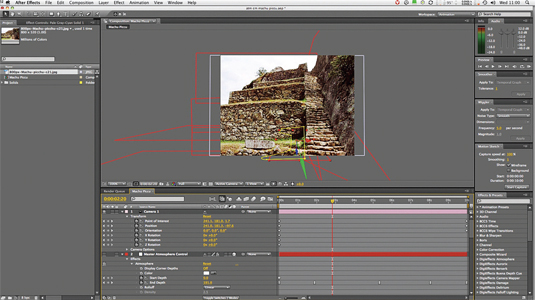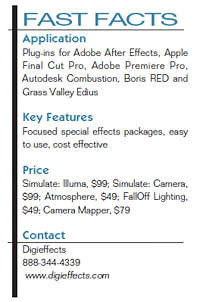Digieffects Plug-Ins
Digieffects was one of the earliest developers of special effects plug-ins for After Effects, starting in 1996 with such stalwarts as Aurorix, Berserk, and Delerium. These broke some new ground for high-quality special effects possibilities in After Effects.
In 2007, the company reorganized and updated all its legacy plug-ins to run with modern operating systems and in multiple hosts. They also began developing new effects packages—smaller, more focused, and more affordable collections such as the five packages under consideration here: Simulate: Illuma, Simulate: Camera, Atmosphere, FallOff Lighting, and Camera Mapper.
FEATURES
Simulate: Illuma provides a number of usable, high quality and easily and fully controllable lighting effects. Its Halo simulates lens diffraction blooms, with parameters for shape, size, density, brightness for each color channel, and also post-effect blur or smoothing. The Lightracer feature simulates a phosphorescent bloom, with controls including randomness, size, shape, and color. Luminus is a glow creation filter with controls for radius (size), intensity, and screen blend mode. Photogust creates light ray effects, and beyond. Radiance is a glow variation that features independent controls for each color channel's intensity and tonal range, with sophisticated blur controls and blend modes.

The Digieffects Atmosphere user interface The Simulate: Camera plug-in provides a variety of natural looking degrading effects. Its Archive transforms your footage into a controlled random simulation of projected footage, including dust, flicker, channel noise, tint, scratches and jitter. Destabilize adds very realistic camera shake to an extremely adjustable degree, with the added bonus that, by adjusting the Color Channel Separation controls, you can simulate (if you wish) chromatic aberrations. The OverExpose feature simulates the "iris hunting" look often found in consumer camera auto iris footage.
Atmosphere does what you might expect, which is to simulate atmospheric conditions such as smog, fog, and haze, but with a few additional and welcome twists and additions. It provides a true 3D, as well as a simulated, 3D effect. In other words, layers or even parts of layers closer to the camera will have a denser effect than those farther away from the camera, seeming to be more or less thoroughly involved in the fog or haze. Falloff Lighting works in a similar way, in 3D, to simulate the manner in which lighting effects diminish over distance.
The Camera Mapper plug-in provides a way to create the illusion that certain objects in your clip are projected in front of the clip itself, providing—or greatly increasing—the perception of depth. It works by starting with a still image or locked-off and stabilized clip, and one or more solid layers, which are then converted into 3D layers. In the process it adds a Render Camera and a Projection Camera, projecting selected alpha channels onto solid layers, and animating and rendering the results. With it, you can easily simulate a 3D scene from 2D footage. While this can be done using the tools native to After Effects and PhotoShop Extended, using Camera Mapper is much simpler and faster.
IN USE
I've found myself using something from Digieffects in most every After Effects project that passes through my studio, which is running AE CS4 on an 8 core MacPro under OSX 10.5 (with lots of RAM). While FCP is not my main editing platform, I have used several of these plug-ins within Final Cut Pro as well. The main difference in how the Digieffects plug-ins function inside different hosts is the user interface. The UI details and parameter settings display differently inside different hosts, but all the remaining functionality and performance is the same. For the purposes of this review, I tried to use as many and as varied Digieffects plug-ins as I could on several music video projects.

There are several common elements in the Simulate: Illuma, Simulate: Camera, and other recent Digieffects plug-in interfaces, having to do with presets, and which makes working with them more convenient. Hopefully, with a few improvements, they will transplant to other plug-ins. These common elements are a row of six buttons at the top of the UI, involving presets. There is a blue Randomizer, which resets all parameters to random starting points, and a red Record button, for setting-up a preset; it records the current state of all parameters. This action creates an XML file, and an unlimited number of these can be stored. However, in order to be accessible from one of the four preset buttons, you must do a little text editing on the XML file to add the preset number to the top of the file, a small and easy to perform job, but annoying and rather a clumsy way to have to work.
All of the above-mentioned plug-ins that I tested were very responsive to parameter changes. They updated previews quickly and were fairly quick to render. Most of the parameters are extremely self-explanatory, and those that aren't are explained by the clear and succinct documentation, supplemented by online tutorials, demo projects, and tutorial movies.
For example, I used the Atmosphere effect on several outdoor shots in one particular project, adding just enough misty fog to make the shots look interesting and a bit mysterious. The plug-in settings gave me enough control to make it look suggestive of fog, rather than fog fully banked-in, and the fall-off factor (the effect dissipates the farther you get from the camera) really helped sell the naturalness. I've always thought that the better a plug-in's interface and design, the more subtle the effects would be that could be achieved with it. All of these plug-ins are more than capable of subtlety. Rendered results, even at HD frame sizes, are very believable and very high quality.
SUMMARY
I very much applaud the design, marketing, and organizational decisions at Digieffects leading to their release of many small, focused, and inexpensive packages of plug-ins. Not only is it much easier to find the plug-in you want, but it's also easier to get the hang of their use and the interactions of their parameter controls.
It should be noted that other Digieffects packages include FreeForm AE, which is a more extensive and comprehensive 3D world inside After Effects. You should definitely try out any of these packages in demo mode, to see their worth for your project and/or workflow.
Michael Hanish operates Free Lunch, a video/audio/multimedia production house near Guilford, Vt. He may be contacted atmichael@freelunchmedia.com.
Get the TV Tech Newsletter
The professional video industry's #1 source for news, trends and product and tech information. Sign up below.
